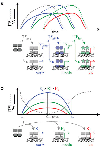Ordering up gene expression by slowing down transcription factor binding kinetics
- PMID: 30353359
- PMCID: PMC6421095
- DOI: 10.1007/s00294-018-0896-7
Ordering up gene expression by slowing down transcription factor binding kinetics
Abstract
Efficient regulation of a complex genetic response requires that the gene products, which catalyze the response, be synthesized in a temporally ordered manner to match the sequential nature of the reaction pathway they act upon. Transcription regulation networks coordinate this aspect of cellular control by modulating transcription factor (TF) concentrations through time. The effect a TF has on the timing of gene expression is often modeled assuming that the TF-promoter binding reaction is in thermodynamic equilibrium with changes in TF concentration over time; however, non-equilibrium dynamics resulting from relatively slow TF-binding kinetics can result in different network behavior. Here, I highlight a recent study of the bacterial SOS response, where a single TF regulates multiple target promoters, to show how a disequilibrium of TF binding at promoters results in a more complex behavior, enabling a larger temporal separation of promoter activities that depends not only upon slow TF binding kinetics at promoters, but also on the magnitude of the response stimulus. I also discuss the dependence of network behavior on specific TF regulatory mechanisms and the implications non-equilibrium dynamics have for stochastic gene expression.
Keywords: DNA damage; Kinetics; LexA; Promoter; SOS response; Transcription factor.
Conflict of interest statement
Conflict of Interest: The author declares that he has no conflict of interest.
Figures


Similar articles
-
Non-equilibrium repressor binding kinetics link DNA damage dose to transcriptional timing within the SOS gene network.PLoS Genet. 2018 Jun 1;14(6):e1007405. doi: 10.1371/journal.pgen.1007405. eCollection 2018 Jun. PLoS Genet. 2018. PMID: 29856734 Free PMC article.
-
Temporal hierarchy of gene expression mediated by transcription factor binding affinity and activation dynamics.mBio. 2015 May 26;6(3):e00686-15. doi: 10.1128/mBio.00686-15. mBio. 2015. PMID: 26015501 Free PMC article.
-
Follitropin action on the transferrin gene in Sertoli cells is mediated by cAMP-responsive-element-binding-protein and antagonized by chicken ovalbumin-upstream-promoter-transcription factor.Eur J Biochem. 1996 Jul 1;239(1):52-60. doi: 10.1111/j.1432-1033.1996.0052u.x. Eur J Biochem. 1996. PMID: 8706718
-
Quantifying transcription factor kinetics: at work or at play?Crit Rev Biochem Mol Biol. 2013 Sep-Oct;48(5):492-514. doi: 10.3109/10409238.2013.833891. Epub 2013 Sep 11. Crit Rev Biochem Mol Biol. 2013. PMID: 24025032 Review.
-
Identification of plant transcription factor target sequences.Biochim Biophys Acta Gene Regul Mech. 2017 Jan;1860(1):21-30. doi: 10.1016/j.bbagrm.2016.05.001. Epub 2016 May 4. Biochim Biophys Acta Gene Regul Mech. 2017. PMID: 27155066 Review.
Cited by
-
A conserved role for transcription factor sumoylation in binding-site selection.Curr Genet. 2019 Dec;65(6):1307-1312. doi: 10.1007/s00294-019-00992-w. Epub 2019 May 15. Curr Genet. 2019. PMID: 31093693 Review.
-
Transcriptional and Epigenetic Bioinformatic Analysis of Claudin-9 Regulation in Gastric Cancer.J Oncol. 2021 Dec 18;2021:5936905. doi: 10.1155/2021/5936905. eCollection 2021. J Oncol. 2021. PMID: 39296813 Free PMC article.
-
Nested information processing in the living world.Ann N Y Acad Sci. 2021 Sep;1500(1):5-16. doi: 10.1111/nyas.14612. Epub 2021 May 26. Ann N Y Acad Sci. 2021. PMID: 34042190 Free PMC article. Review.
-
Effective in vivo binding energy landscape illustrates kinetic stability of RBPJ-DNA binding.Nat Commun. 2025 Feb 1;16(1):1259. doi: 10.1038/s41467-025-56515-4. Nat Commun. 2025. PMID: 39893191 Free PMC article.
References
-
- Butala M, Klose D, Hodnik V, Rems A, Podlesek Z, Klare JP, Anderluh G, Busby SJ, Steinhoff HJ, Zgur-Bertok D (2011) Interconversion between bound and free conformations of LexA orchestrates the bacterial SOS response. Nucleic Acids Res. 39:6546–6557. doi: 10.1093/nar/gkr265 [doi] - DOI - PMC - PubMed
Publication types
MeSH terms
Substances
Grants and funding
LinkOut - more resources
Full Text Sources
Miscellaneous

